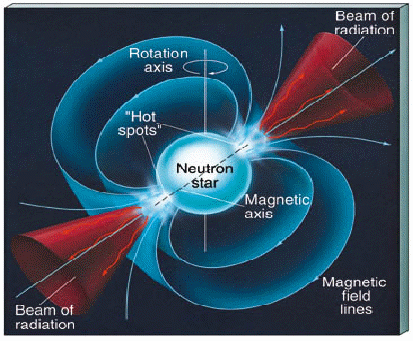Neutron Stars
When stars reach the end of their lives, they go through the giant or supergiant and supernova phases and depending on the mass of the stellar remnant the star may become one of three things.
If the mass of the stellar remnant is less than about 1.4 solar masses, the remnant becomes a white dwarf. A white dwarf is like a giant, Earth sized atom, made up of nuclei of various sorts – carbon etc configured as a single giant nucleus - and electrons. Quantum physics predicts that the electrons exert a pressure to stop further collapse. This pressure is only sufficient to prevent collapse of the star if the stellar remnant is less than about 1.4 solar masses.
If the mass of the stellar remnant is between about 1.4 and 3 solar masses, the force of gravity exceeds the force due to electron degeneracy pressure. The collapse proceeds and the star becomes a neutron star.
Neutron stars are a few km across – a Sun size mass packed into a space the size of a medium sized town. - made up entirely of neutrons. Quantum physics predicts they exert a pressure which support the star against further collapse.
Pulsars

Many neutron stars exhibit quite extreme features. The original angular momentum and gravitational fields – less any carried away by the suoernova explosion – are now concentrated into a small volume maybe 10km in radius. This typically means very large magnetic fields and very fast rotation of the stellar remnant. The magnetic field exits the poles of the star, and if the poles are not aligned with the axis of rotation, the beams can trace out giant cines in space. If the earth lies in the path traced by one of these cones we will be able to detect a signal which goes beep – beep – beep – beep very rapidly, sometimes many times a second. Such neutron stars are called Pulsars. When they were originally detected in the 1860s, the discoverers thought it was evidence of intelligent extra terrestrial life.